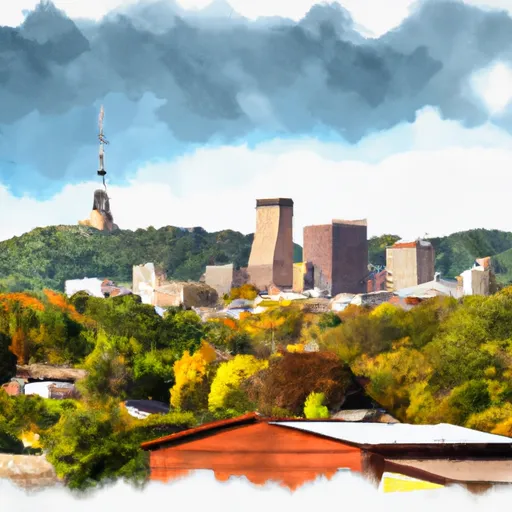-
 Snoflo Premium
Snoflo Premium
Get unlimited access to all our content
With no Ad interruptions! - Start Your Free Trial Login with existing account
Red-Boiling-Spri
Eden Index
Climate
7.8
•
Recreation
1.7
•
Community
1.8
•
Safeguard
4.2/10

Red Boiling Springs is a charming town located in Macon County, Tennessee. The climate in this area is generally mild, with hot summers and cool winters. Summers are characterized by temperatures ranging from the mid-80s to low 90s Fahrenheit, while winter temperatures can drop to the mid-30s to low 40s Fahrenheit. The town experiences moderate rainfall throughout the year.
One of the remarkable features of Red Boiling Springs is its hydrology constituents. The town is nestled in the heart of the Cumberland Plateau, an area known for its numerous springs. The region boasts a variety of mineral-rich hot springs, which are believed to possess healing properties due to the high mineral content. These springs attract visitors seeking relaxation and therapeutic experiences.
Outdoor recreation opportunities abound in and around Red Boiling Springs. The nearby parks and forests offer excellent opportunities for hiking, camping, and wildlife observation. Within a short drive, visitors can explore attractions such as the Cumberland River, where fishing and boating are popular activities. Additionally, the area is home to several golf courses, providing opportunities for enthusiasts to enjoy a round of golf amidst the picturesque scenery.
Red Boiling Springs is a delightful destination for those seeking a tranquil retreat surrounded by natural beauty, mineral-rich springs, and a range of outdoor activities.
What is the Eden Index?
The Snoflo Eden Index serves as a comprehensive rating system for regions, evaluating their desirability through a holistic assessment of climate health, outdoor recreation opportunities, and natural disaster risk, acknowledging the profound impact of these factors on livability and well-being.
Climate Health Indicator (CHI): 7.8
Red-Boiling-Spri receives approximately
1333mm of rain per year,
with humidity levels near 87%
and air temperatures averaging around
15°C.
Red-Boiling-Spri has a plant hardyness factor of
7, meaning
plants and agriculture in this region tend to thrive during the non-winter months.
By considering the ideal temperature range, reliable water supplies, clean air, and stable seasonal rain or snowpacks, the Climate Health Indicator (CHI) underscores the significance of a healthy climate as the foundation for quality living.
A healthy climate is paramount for ensuring a high quality of life and livability in a region, fostering both physical well-being and environmental harmony. This can be characterized by ideal temperatures, reliable access to water supplies, clean air, and consistent seasonal rain or snowpacks.
Weather Forecast
Streamflow Conditions
Green
Area Rivers
Green
Snowpack Depths
Green
Reservoir Storage Capacity
Green
Groundwater Levels
Recreational Opportunity Index (ROI): 1.7
The Recreational Opportunity Index (ROI) recognizes the value of outdoor recreational options, such as parks, hiking trails, camping sites, and fishing spots, while acknowledging that climate plays a pivotal role in ensuring the comfort and consistency of these experiences.
Access to outdoor recreational opportunities, encompassing activities such as parks, hiking, camping, and fishing, is crucial for overall well-being, and the climate plays a pivotal role in enabling and enhancing these experiences, ensuring that individuals can engage in nature-based activities comfortably and consistently.
Camping Areas
| Campground | Campsites | Reservations | Toilets | Showers | Elevation |
|---|---|---|---|---|---|
| Anniston Army Depot RV Military | None | 635 ft | |||
| Pine Glen | 31 | 990 ft | |||
| Stevenson Municipal Park - Guntersville Reservoir | None | 599 ft | |||
| Holmes Creek - Center Hill Lake | None | 749 ft | |||
| Noccalula Falls Campground | None | 732 ft | |||
| Shellmound - Nickajack Dam Reservation | None | 678 ft | |||
| Dekalb County Public Lake | None | 1,317 ft | |||
| Jackson County Park | None | 627 ft | |||
| Foster Falls | 26 | 1,780 ft | |||
| De Soto State Park | 94 | 1,477 ft |
Nearby Ski Areas
Catastrophe Safeguard Index (CSI):
The Catastrophe Safeguard Index (CSI) recognizes that natural disaster risk, encompassing floods, fires, hurricanes, and tornadoes, can drastically affect safety and the overall appeal of an area.
The level of natural disaster risk in a region significantly affects safety and the overall livability, with climate change amplifying these risks by potentially increasing the frequency and intensity of events like floods, fires, hurricanes, and tornadoes, thereby posing substantial challenges to community resilience and well-being.
Community Resilience Indicator (CRI): 1.8
The Community Resilience Indicator (CRI) recognizes that education, healthcare, and socioeconomics are crucial to the well-being of a region. The CRI acknowledges the profound impact of these elements on residents' overall quality of life. By evaluating educational resources, healthcare accessibility, and economic inclusivity, the index captures the essential aspects that contribute to a thriving community, fostering resident satisfaction, equity, and social cohesion.

